ISSN ONLINE(2278-8875) PRINT (2320-3765)
ISSN ONLINE(2278-8875) PRINT (2320-3765)
D.Umamageswari1, L.Sivasakthi1, R.Vani2
|
| Related article at Pubmed, Scholar Google |
Visit for more related articles at International Journal of Advanced Research in Electrical, Electronics and Instrumentation Engineering
Image enhancement plays an important role in image processing and analysis. The existing system assumes that the sensations of color have a strong correlation with reflectance and the amount of visible light reaching observers depends in the product of reflectance and illumination. The main objective of our project is to propose a new image enhancement method to enhance the image as well as to preserve the naturalness of an image. Here, we propose a naturalness preserved enhancement method for non-uniform illumination images using transformation techniques.
Keywords |
| Fast Fouier Transform, Bilog transform, Image enhancement, naturalness, Resolution |
INTRODUCTION |
| Image processing is defined as the process of analyzing and manipulating images using a computer. Using computer algorithms to perform image processing on digital images is referred as Digital image processing. Image Enhancement is simple and most appealing areas among all the digital image processing techniques. Image enhancement is to improve the image quality so that the resultant image is better than the original image for a specific application. Hence Image Enhancement is a “subjective process” which means that the human perception decides the best method from the obtained results. As we know that frequency domain methods first transform the images into transform domain or frequency domain and then operate on the transformed images. After the process, the images are transformed back to spatial domain by applying inverse transforms. Overview of transformation techniques is discussed. |
| The Discrete Fourier Transform (DFT) is the sampled Fourier Transform and therefore does not contain all frequencies forming an image, but only a set of samples which is large enough to fully describe the spatial domain image. For a square image of size N×N, the twodimensional DFT is given by, |
 |
| Where f(i,j) is the image in the spatial domain and the exponential term is the basis function corresponding to each point F(k,l) in the Fourier space. In a similar way, the Fourier image can be re-transformed to the spatial domain. The inverse Fourier transform is given by: |
 |
| The main disadvantages of using DFT, the speed is very slow when compared with FFT. The number of computations for a DFT is on the order of N Squared.The Fourier Transform is used in a wide range of applications in image processing, such as image analysis, image filtering, image reconstruction and image compression. Fast Fourier Transform (FFT) is an efficient implementation of DFT and it is an important tool used in image processing. Fast Fourier Transform is applied to convert an image from the image (spatial) domain to the frequency domain. Applying filters to images in frequency domain is computationally faster than to do the same in the image domain. An inverse transform is then applied in the frequency domain to get the result of the convolution. The FFT and its inverse of a 2D image are given by the following equations: |
 |
| Twiddle factor, WN=exp(-j2π(xm/N+yn/N)) |
| where f(m,n) is the pixel at coordinates (m, n), F(x,y) is the value of the image in the frequency domain corresponding to the coordinates x and y, M and N are the dimensions of the image. |
| The interesting property of the FFT is that the transform of N points can be rewritten as the sum of two N/2 transforms (divide and conquer). This is important because some of the computations can be reused thus eliminating expensive operations. The FFT-based convolution method is most often used for large inputs. For small inputs it is generally faster to use imfilter. A discrete cosine transform (DCT) expresses a finite sequence of data points in terms of a sum of cosine function oscillating at different frequencies. The use of cosine rather than sine functions is critical in those applications, for compression it turns out that cosine functions are much more efficient, whereas for differential equations the cosines express a particular choice of boundary conditions. |
| The 1 D forward discrete cosine transform is defined, |
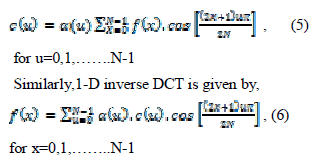 |
| The Discrete Cosine Transform (DCT) is used in many applications by the scientific, engineering and research communities and in data compression in particular. |
| The bilog transform smoothly modifies the gradient of the transformation so that in the region near zero it remains finite. A single constant C is provided to tune this behavior, so as to adjust the meaning of “region near zero”. The default value of this constant is 1/ ln(10); this gives a unity transfer function at zero but other values can be applied as wished, to focus into the region near zero or not. The modified logarithmic transformation called Bilog transform can be both one-sided or symmetric, and thus can transform negative data to scaled negative data. It can be applied to both the X and Y data, when it becomes a bi-symmetric log transform. The slope(or transfer function) k(x) is given by, |
| A simple smoothly acting, inverse limiting function is then applied to this transfer function k(x), such that k(x) has a value of unity at x = 0 : |
| k(x) = (1 + (x/C))−1 (7) |
| The constant C adjusts the slope of the transfer function near the origin. Default value 1/ ln(10) then gives a unity slope transfer function near the origin : |
| k(x) = (1 + x ln (10))−1 (8) |
| These transformations are very easy to implement. Mostly used in array based computer languages. The applications of image enhancement are Aerial imaging, Satellite imaging, Medical imaging, Digital camera application, Remote sensing. Some of the areas in which IE has wide application [9] are noted. |
| The remainder of this paper is organized as follows. The next section presents the observation on detail enhancement and natural preservation. Section III gives the proposed algorithm. Section IV explains the experiments and results. Finally, the paper is concluded in section V. |
EXISTING METHODOLOGIES |
| In this section we present the observation on various papers and its drawbacks. Histogram equalization (HE) [8] is one of the common methods used for improving contrast in digital images. However, this technique is not very well suited to be implemented in consumer electronics, such as television, because the method tends to introduce unnecessary visual deterioration such as the saturation effect. One of the solutions to overcome this weakness is by preserving the mean brightness of the input image inside the output image. |
| In most cases, BPDHE successfully enhance the image without severe side effects, and at the same time, maintain the mean input brightness. BPDHE preserves the intensity of the input image, it is disadvantageous to highlight the details in areas of low intensity. Brightness preserving histogram equalization (BPDHE) is not suitable for non-uniform illumination images. LHE method tries to eliminate the above problem. It makes use of the local information remarkably. However, LHE [5] demands high computational cost and sometimes causes overenhancement in some portion of the image. Nonetheless, these methods produce an undesirable checkerboard effects on the enhanced images. |
| The BBHE method decomposes the original image into two sub-images, by using the image mean gray level, and then applies the HE method on each of the sub images independently. At some extent BBHE preserves brightness of image; however generated image might not have a natural appearance. DSIHE is similar to BBHE but DSIHE [5] uses median value as separation intensity to divide the histogram into two sub-histogram. The algorithm enhances only the image visual information effectively, but does not preserve the details and naturalness. The essence of the named Brightness Preserving Histogram Equalization with Maximum Entropy (BPHEME) [3] tries to find the mean brightness is fixed, then transforms the original histogram to that target one using histogram specification. In the consumer electronics [4] such as TV, the preservation of brightness is highly demanded. |
| MMBEBHE is an an extension of the BBHE method. In MMBEBHE [5] the separation intensity is minimum mean brightness error between input image and output image Then Minimum Mean Brightness Error Bi- Histogram Equalization (MMBEBHE) is proposed to preserve the brightness optimally. RMSHE [9] is an iterative technique of BBHE, instead of decomposing the image only once, the RMSHE method proposes for performing image decomposition recursively, up to a scalar r, generating 2r sub-image. Actually, when r grows to infinite, the output histogram is exactly the input histogram, and thus the input image will be output without any enhancement at all. |
| Multi histogram equalization(MHE) techniques have been proposed to further improve the mean image brightness preserving capability. MHE proposed a technique for image enhancement based on curvelet transform [2] and perceptron network. In the process of calculating the pixel difference some values are rejected but these values are part of actual image data. Calculation of pixel differences is difficult ,also time complexity of perceptorn network. |
| The theory based on retinex and lightness decomposition [6] is also an image enhancement method .This enhances details and preserves the naturalness simultaneously. The naturalness of non-uniform illumination images cannot be effectively preserved. Also, proposed finds complexity in real-time applications. |
| The naturalness preserved enhancement algorithm for non-uniform illumination images discusses the three major issues, namely, the naturalness preservation, the intensity decomposition, and the illumination effect were discussed. However this algorithm can only enhance and preserve the naturalness of an image, but the enhanced output seems to be an animated image. |
PROPOSED METHOD FOR NATURALNESSS PRESEVATION |
| The main objective is to propose a new image enhancement algorithm to preserve the naturalness of an image. This overcomes the drawback of the existing system and the proposed method can be applied for all kinds of image, also a dark image can be brighten to visualize the dark image information. This method anlyses:Fast Fourier Transform, Bilog Transformation, NTSC Color Space Enhancement. |
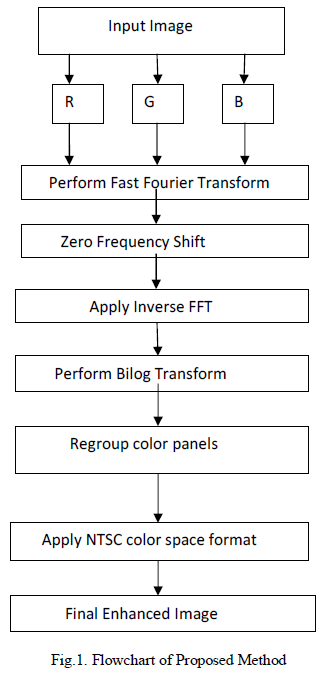 |
| A. Apply Fast Fourier Transform |
| The input image is a color image and this color image consists of three primary spectral components of red, green and blue i.e., RGB color panels. This RGB color Panels has to be segregated to grayscale images i.e., binary images. HSV. FFT filter is used to filter the pixels based on intensity. Then the low frequency components representing zeros are to be shifted to the center of array matrix in frequency domain. Inverse operation is performed to reconstruct the image in frequency domain to its spatial domain so as to picturize the image. |
| B. Apply Bilog Transformation |
| Still there may be some presence of negative frequency components(zero frequency components). Bilog transformation is made use off here to perform action on low frequency information. The region near zeros are to be highlighted for the enhancement and brightness preservation. Hence, after the application of this transform,the region around zeros are enhanced. This is followed by grouping of pixels, where clustering is done to increase the high resolution pixels.At this stage, the image pixels are converted back to RGB color model and pixels highlighted to a certain level. |
| C. NTSC Color Space Enhancenent |
| Further enhancement is done using NTSC format. The NTSC(national television system committee) color space is used in televisions in the United States.In this format the RGB color panels are converted to YIQ and converting back YIQ panels to RGB color model to process the gray scale and color information present in the image Hence, the resulting image is an enhanced image. |
| The, algorithm steps are as follows: |
| STEP 1: Read image from the file and display the image. Convert RGB color panels to HSV i.e., to binary images STEP 2: Initialize the input image matrix as KLAP and other variables and Rewrite the values of matrix by comparing it with the original image matrix |
| STEP 3: Use FFT filter to perform FAST FOURIER TRANSFORM, as FFT filter is used to filter the pixels based on intensity i.e., low resolution pixels and high resolution pixels. |
| STEP 4: Use Envelope function to convert low resolution pixels into high resolution pixels. Perform Inverse FFT wherever needed to reconstruct the image |
| STEP 5: Perform BILOG TRANSFORM ,as image does not contain same pixels some might be very large or small and regroup Pixels using envelope check function to increase high resolution pixels in image. |
| STEP 6: Further enhance the image using NTSC format. Cost function performs the NTSC color space enhancement. |
| STEP 7:Enhance the image by performing L .*R and Convert back HSV into RGB image to view image in RGB color model. |
PERFORMANCE MEASURE |
| The Results are analyzed using both objective assessment and subjective assessment. |
| Subjective Assesment |
| Subjective assessment always depends on human visual system. For a natural image very often human visual system gives the final evaluation of the processed image. |
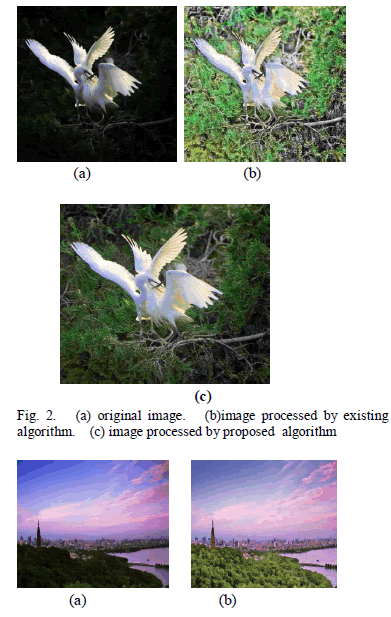 |
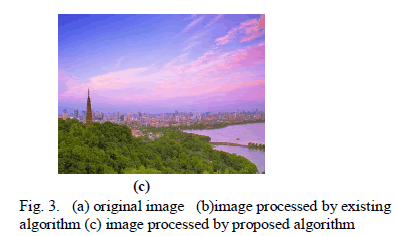 |
| B. Objective Assessment |
| Objective assessment is often used to explain some important characteristics of the image. We assess the detail enhancement from the below table I. Meanwhile we assess the naturalness preservation for non-uniform illumination images. |
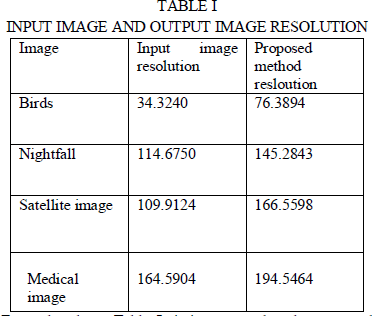 |
| From the above Table I, it is proven that the proposed method acts on various images and produces output images having high resolution |
CONCLUSION |
| Our proposed method for image enhancement has applied on several non-uniform illumination images. To evaluate the effectiveness of proposed method, we make use of histogram in table I, and this represents the resolution of the image. Hence, our project proposes a new enhancement method for non-uniform illumination images, which not only enhances the details of the image but also preserves the naturalness. the enhanced images, we can see that our proposed method preserves the ambience as well as enhances the details present in the image. Experimental results demonstrate that the images enhanced by the proposed algorithm are visually pleasing, artifact free, and natural looking. However, our enhancement algorithm is based on only a pair of transform, and thefuture enhancement is on analyzing with the other pair of transforms. |
References |
|